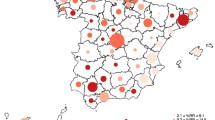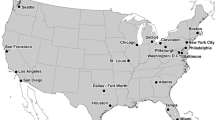Abstract
An index depicting the severity of summer weather was developed for New York City and was used to examine the severity of summers during the period 1946–1975. This index incorporates various important parameters of summer weather and is primarily intended to represent the likely impact of summer weather on human comfort, morbidity, and mortality. This index would be applicable in areas that have a distribution of summer weather parameters characteristic of humid continental warm summer climate types. A linear regression of the Summer Severity Index against time was performed and indicated no significant trends in summer severity over the period of record.
Similar content being viewed by others
References
BLUM, H. F. (1961): Times arrow and the evolution of society. University Mag., 9: 9–13.
BLUM, H. F. (1964): Effects of sunlight on the human body. In: Medical S. Licht (ed.), L. Licht Publ., New Haven, Conn., 229–254.
BLUM, H. F. (1964): Effects of sunlight on the human body. In: Medical Climatology, S. Licht (ed.), L. Licht Publ., New Haven, Conn., 229–254.
BRIDGER, C. A. and HELFAND, L. A. (1968): Mortality from heat during July 1966 in Illinois. Int. J. Biometeorol., 12: 41–70.
BROTAK, E. A. and SHULMAN, M. D. (1973): A study of temperature trends in New Jersey. Bull. N.J. Acad. Sci., 18: 1–7.
BUECHLEY, R. W., VAN BRUGGEN, J. and TRUPPI, L. E. (1972): Heat islanddeath island. Environ. Res., 5: 85–92.
CLARKE, J. F. (1972a): Some climatological aspects of heat waves in the contiguous United States. Environ Res., 5: 76–84.
CLARKE, J. F. (1972b): Some effects of the urban structure on heat mortality. Environ. Res., 5: 93–104.
CONOVER, J. H. (1967): Are New England winters getting milder? Weatherwise, 20: 58–61.
CRITCHFIELD, H. J. (1960): General Climatology. Prentice-Hall, Englewood Cliffs, N.J. 198–202.
EICHENLAUB, V. L. (1971): Further comments on the climate of the midnineteenth century United States compared to current normals. Mon. Weather Rev., 99: 847–850.
ELLIS, F. P. (1972): Mortality from heat illness and heat-aggravated illness in the United States. Environ. Res., 5: 1–58.
FIELD, F. (1974): Measurement of weather. In: Medical Climatology. S. Licht (ed.), L. Licht Publ., New Haven, Conn., 42–75.
HENSCHEL, A., BURTON, L., MARGOLIES, L. and SMITH, U. E. (1968): An analysis of heat deaths in St. Louis during July 1966. Environmental Control Administration, Cincinnati, Ohio, 22 pp. (available from ASTIA as AD 667382).
HUGHES (1967): Summers in Manchester. Weather, 22: 199–200.
KINCER, J. B. (1933): Is our climate changing — an examination of long-term temperature trends. Mon. Weather Rev., 61: 251–259.
KUTSCHENREUTER, P. H. (1959): A study of the effect of weather on mortality. Trans. N.Y. Acad. Sci., 22: 126–138.
LANDSBERG, H. E. (1969): Weather and Health. Doubleday, Garden City, New York.
LANDSBERG, H. E. (1967): Two centuries of New England and climate. Weatherwise, 20: 52–57.
MITCHELL, J. M., JR. (1956): Link warmer climate to city growth. Heat Piping Air Con., 28: 92–97.
OECHSLI, F. W. and BUECHLEY, W. B. (1970): Excess mortality associated with three Los Angeles September hot spells. Environ. Res., 3: 277–284.
POULTER (1962): The next few summers in London, Weather, 17: 253–255.
RODEN, G. I. (1966): A modern statistical analysis and documentation of historical temperature records in California, Oregon, and Washington 1821–1964. J. appl. Meteorol., 5: 3–24.
RUBINFELD, M. D. and SHULMAN, M. D. (1976): A winter severity index for central New Jersey. Bull. N.J. Acad. Sci., 21: 1–5.
SCHUMAN, S. H. (1972): Patterns of urban heat wave deaths and implications for prevention: data from New York and St. Louis during July 1966. Environ. Res., 5: 59–75.
SPAR, J. and MAYER, J. A. (1973): Temperature trends in New York City: A postscript. Weatherwise, 26: 128–130.
WAHL, E. W. and LAWSON, T. L. (1970): The climate of the mid-nineteenth century United States compared to current normals. Mon. Weather Rev., 98: 259–265.
WINTERLING, G. A. (1967): Florida's recent cool cycle commencing with snow at Jacksonville. Weatherwise, 20: 72–74.
Author information
Authors and Affiliations
Rights and permissions
About this article
Cite this article
McLaughlin, J.T., Shulman, M.D. An anthropocentric Summer Severity Index. Int J Biometeorol 21, 16–28 (1977). https://doi.org/10.1007/BF01552963
Received:
Issue Date:
DOI: https://doi.org/10.1007/BF01552963




